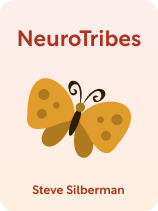

This article is an excerpt from the Shortform book guide to "NeuroTribes" by Steve Silberman. Shortform has the world's best summaries and analyses of books you should be reading.
Like this article? Sign up for a free trial here.
How do autistic brains differ from allistic brains? Why isn’t Asperger’s syndrome a legitimate diagnosis anymore? What is the only cure for autism?
Every day, people with autism are forced to exist in a world that’s not designed for their brains. In the book NeuroTribes by Steve Silberman, he explores the history, characterization, and evolving societal perception of autism.
Whether you or someone you know is autistic or you’re simply curious about autism, here’s an overview of NeuroTribes.
NeuroTribes: The Legacy of Autism and the Future of Neurodiversity, an Overview
In NeuroTribes by Steve Silberman, he explores the history, characterization, and evolving societal perception of autism. He challenges the prevalent myths and misconceptions about autism, celebrates the unique strengths of autistic individuals, and advocates for a more inclusive society that recognizes and respects neurological differences.
Silberman is an award-winning writer who’s contributed to publications such as Wired, The New York Times, the MIT Technology Review, and Nature. He’s won several awards for NeuroTribes, including the 2015 Samuel Johnson Prize for Non-Fiction, and in 2016 he delivered the keynote speech at the United Nations for World Autism Awareness Day.
(Shortform note: Throughout the guide, we’ll use the term “allistic” to refer to people who aren’t autistic.)
What Is Autism?
Silberman explains that autism is a developmental disorder with a wide range of traits that impact different areas of a person’s functioning and experiences. These areas include social interaction and communication, sensory processing and sensitivities, and behavioral and cognitive patterns. In this section, we’ll explain some of the most common characteristics, grouped according to these areas.
Silberman emphasizes that no two autistic people are exactly alike and that all of the following characteristics exist on a spectrum, which means any given autistic person may demonstrate these traits to varying degrees (or not at all). This is also not a comprehensive list of autistic traits.
Area #1: Social Interaction and Communication
Silberman touches on two specific ways in which autistic people may struggle with social interactions: difficulty following social norms and difficulty communicating with others.
Difficulty Following Social Norms
According to Silberman, autistic people often struggle with different aspects of social interaction, which can lead to isolation, alienation by their peers, or avoidance of social interaction. Silberman describes some specific ways autistic people struggle to interact with others.
First, they may have difficulty making eye contact—a struggle also known as gaze aversion.
Second, they may have trouble connecting with their peers, so autistic children often gravitate toward adults rather than other children.
Third, they often have solitary tendencies and feel less inclined to participate in social activities, but they also have rich internal lives that keep them entertained and engaged.
Difficulty Communicating
Silberman also explains that autistic people can struggle with communicating—particularly with expressing their thoughts, feelings, and needs.
Silberman describes several differences in communication that many autistic people experience.
First, they may communicate through echolalia, or the practice of repeating things they’ve heard from others. This can include repeating words or phrases verbatim without adapting them for context. For example, an autistic child who wants a snack may ask for it by saying, “Do you want a cookie?” rather than, “I want a cookie.”
Second, they may struggle to notice and/or convey irony or sarcasm, which can lead to the misconception that autistic people can’t understand irony or humor. This may be somewhat related to literal thinking, which we’ll describe in greater detail later.
Area #2: Sensory Processing and Self-Regulation
Silberman also notes two major differences in the neural functioning of autistic people versus allistic people, specifically in terms of processing sensory input and self-regulating.
Processing Sensory Stimuli
Silberman explains that autistic people’s brains tend to process stimuli differently than allistic people. They often have extreme sensory sensitivities, as well as a much lower threshold for the sensory input they can handle without becoming overwhelmed. As a result, they find ways of regulating their brains to avoid sensory overload. For example, an autistic person attending a party might need to take a break and go sit alone in a quiet room for a while to keep their system from becoming overloaded, whereas an allistic person might not have trouble handling that much sensory input.
Methods of Self-Regulation
To manage the sensory input they receive, autistic people often rely heavily on routines. For example, they may eat the same food for every meal or wear the same clothes every day to avoid overstimulation from unfamiliar tastes or fabric textures. Interruptions to their routines or changes in familiar environments are often distressing.
Autistic people also often engage in repetitive movements or behaviors—called “stimming,” short for self-stimulatory behavior. Stimming can include rocking back and forth, flapping their hands, echolalia, or holding or playing with a specific object. According to Silberman, autistic people stim for many reasons, including to reduce anxiety; to express different emotions like happiness, boredom, and frustration; or simply because it feels good.
Area #3: Behavioral and Cognitive Patterns
Silberman explains that autistic people also behave and think differently from their allistic peers. They often have deep passions known as special interests, have a tendency for literal thinking, and view things from a unique perspective.
The Beginning of Our Clinical Understanding of Autism
While we now have a broad understanding of many aspects of autism, this understanding is relatively new—prior to the mid-20th century, autism wasn’t identified as its own distinct disorder, and little research had been done on it. In this section, we’ll look at the origins of our clinical understanding of autism.
Silberman writes that the history of autism research began with the work of Austrian physician Hans Asperger in the 1930s and 1940s. Asperger believed that disabled children weren’t defective—as most people believed at the time—but simply had unique needs and strengths. He and the other staff at his clinic saw over 200 children, as well as many teenagers and adults, who demonstrated many of the traits of autism we described earlier.
Through years of research and working with autistic people, Asperger concluded that autism is a relatively common disorder that encompasses a wide range of both ability and disability. He also concluded that it’s hereditary—often passing down from parent to child—and lifelong. And importantly, he noticed that it occurs along a wide spectrum; he suggested that every autistic person experiences a different type of autism.
According to Silberman, while prior research into autism primarily focused on deficits, Asperger noticed that many autistic people had unique skill sets and cognitive abilities. He called these skills and abilities “autistic intelligence.” He noticed that people in the sciences seemed particularly likely to show autistic traits, and he theorized that autism was more common in such fields because autistic intelligence often lent itself well to such work. Abstract reasoning, creative and novel thinking, and passionate interests are highly beneficial in science and may give autistic people an advantage over their allistic peers.
Asperger suggested that autistic people have always made important contributions to culture and human progress, and he argued vehemently in favor of their value as human beings.
How Society Viewed Disabled People: The Eugenics Movement
While Asperger and many of his colleagues saw disabled people as valuable humans who deserved basic rights, many at the time believed otherwise, explains Silberman.
In the years following World War I, many people in America began to adopt eugenicist views. Eugenics was a pseudoscientific movement devoted to creating the ideal human by stamping out traits viewed as undesirable. Eugenicists believed that allowing certain groups of people to live and reproduce would cause a reverse natural selection process in which the worst elements of human nature would be passed on to successive generations while the best elements would be lost.
According to Silberman, eugenicists used a very strict definition of the “best” human qualities. Their idea of the “perfect” human was one who was white, of Northern European descent, physically and mentally able, and free of all disease. This excluded Black people, Native Americans, Jewish people, and disabled people, among many others. They viewed disabled people as defectives and moral degenerates unworthy of life. Throughout the first half of the 20th century, many US states allowed health officials to forcibly sterilize people in mental asylums, prisons, and schools for mentally disabled children.
As these ideas spread to Germany, Silberman explains, they became the basis for much of the Nazis’ ideology and genocidal tactics. In the next sections, we’ll explain how Nazi Germany adopted eugenics and used it to justify their extermination of disabled people. Then we’ll look at how this shaped the way Asperger presented his findings on autism to the world.
Nazi Germany’s Embrace of Eugenics
According to Silberman, though eugenicist ideology initially developed in America, post-World War I Germany quickly embraced these ideas. Silberman suggests that this is partly because World War I had cost the lives of a generation of healthy soldiers—young, physically fit males who embodied the eugenicist idea of the “perfect” human. People feared that this loss left a disproportionate number of “defective” people who would reproduce and reduce the overall quality of the German populace.
Hitler crafted his vision for a “perfect” society around these eugenicist ideas. As he rose to power, the German government legalized the forced sterilization of German citizens who had schizophrenia, epilepsy, congenital deafness, or alcoholism, among other conditions.
Throughout the 1930s, the medical field in Germany became overrun with Nazis. Many who opposed their ideology were fired or sent to concentration camps. Though many of his colleagues joined the Nazi party and helped them carry out the Holocaust, Asperger refrained from doing so, according to Silberman. He also refused to report his patients to the Reich Committee, which determined whether a disabled person would be euthanized—sometimes based on nothing more than a person’s score on an IQ test.
According to Silberman, Asperger tried to speak out in favor of the value of disabled people’s lives without overtly defying the Nazis—as we’ll see in the next section, he curated the results of his research to try to dispel the idea that autistic people were worthless—but the eugenicist belief that disabled people deserved to be exterminated prevailed.
Asperger’s Thesis: Consequences for Future Autism Research
In 1944, explains Silberman, Asperger published his thesis on autism. His goal was, in part, to demonstrate that autistic people could make valuable contributions to society in the hope that this would help spare them from the Nazis’ slaughter of those they considered “worthless.” Because of this, he chose to focus his paper on just four specific cases out of the hundreds of autistic children he’d studied. The children in these four cases had no severe impairments and displayed exceptional abilities in math and science. He tried to make the case that people with such abilities could be useful to the Nazis as code breakers.
According to Silberman, this well-intentioned choice had long-lasting, damaging consequences for the field of autism study: Whereas Asperger knew that autism wasn’t rare and that it was a broad spectrum, his published work made it seem like autism was strictly defined and not at all severe. This led other researchers to believe that the condition Asperger studied was a separate condition from autism. (It also later led to the development of the diagnosis of Asperger’s syndrome, now colloquially understood to be a subtype of autism, though it no longer appears in the Diagnostic and Statistical Manual of Mental Disorders, or DSM).
Leo Kanner: The Leading Autism Research in America
At the same time that Asperger was studying autistic children in Vienna and drafting his thesis, child psychiatrist Leo Kanner was studying autism in America. Silberman explains that Kanner was one of the most prominent psychiatrists in America, and his work on autism became the defining research for many years.
Though Kanner worked with some of Asperger’s colleagues (those who came to America to flee the Nazis), Kanner’s work never mentions Asperger’s. Silberman suggests that Kanner refrained from acknowledging Asperger’s research—as well as the research of others who’d studied autism under different names, like childhood schizophrenia—because he saw himself as the lone discoverer of autism.
The Differences Between Asperger’s and Kanner’s Approaches
According to Silberman, Kanner approached autism research differently than Asperger did, which led to discrepancies in their findings and—Silberman suggests—inaccuracies in Kanner’s. Silberman describes four main differences between Kanner’s and Asperger’s research: the age of the subjects, the range of their traits, the rarity and severity of their traits, and the belief in what causes autism.
Difference #1: Age of Subjects
While Asperger studied both children and adults, Kanner limited his study to very young children. Because of this, diagnostic criteria were limited to early childhood behaviors, meaning that teens and adults who weren’t diagnosed in childhood often went undiagnosed for the rest of their lives.
Difference #2: Range of Traits
According to Silberman, Kanner also ignored the individual differences between his patients and described autism according to very restrictive criteria. He viewed autism as a monolithic disorder with few or no variations—as opposed to the spectrum Asperger identified.
Difference #3: Rarity and Severity
Additionally, Kanner defined autism as being extremely rare and very severe, explains Silberman. This clashed with Asperger’s understanding of autism as relatively common and presenting on a spectrum. While Asperger intentionally worked with children of all different levels, Kanner placed himself at the top of the autism assessment and treatment hierarchy, guaranteeing that he would only see the most severe cases.
Difference #4: Cause
Finally, Silberman explains that Asperger and Kanner differed in their beliefs on what caused autism: While Asperger felt confident that it was a genetic disorder passed on through families, Kanner instead promoted the idea that it was a condition caused by insufficiently affectionate parenting in a child’s early years.
Because Kanner’s work was so well-known while Asperger’s was virtually unheard of, the medical field came to view autism as a severely disabling, extremely rare disorder inflicted by bad parenting—a misunderstanding that lasted for decades to come.
A New Perspective on Autism: The Work of Bernard Rimland
According to Silberman, the theory that poor parenting causes autism prevailed in the medical field until the 1960s, when Navy psychologist Bernard Rimland (who had an autistic son) published a book arguing that autism wasn’t caused by childhood trauma but was instead a genetic disorder.
Rimland’s book took the blame for autism off of the parents, Silberman explains. It also took the experiences of autistic children into account in a way that had rarely been done before: Rimland theorized about what it was like to exist in a world not built for them and sympathized with the frustration that must come from meeting all the seemingly arbitrary demands of adults whose brains worked differently. However, not all of his work holds up to modern scrutiny, as we’ll see next.
Rimland’s Problematic Theories
While much of Rimland’s work helped progress the field of autism research, he also promoted other, ultimately harmful theories, Silberman explains. For instance, Rimland agreed with Kanner’s strict definition of what constituted autism and believed it wasn’t a spectrum. He also posited that while autism was genetic, environmental factors such as diet and metabolism could exacerbate it. This began a movement known as the biomedical movement (or BioMed for short). This movement was devoted to “curing” autism through dietary changes (like gluten-free or ketogenic diets), supplements, medication, and chelation (the use of drugs that bind to toxic metals in the blood, allowing the body to then flush out the toxic metals).
Rimland also promoted the idea that vaccines caused autism. Though it’s since been debunked, this idea gained greater traction in the late 1990s, when gastroenterologist Andrew Wakefield published a paper claiming that chemicals in the MMR (measles, mumps, and rubella) vaccine had caused an autism epidemic. The paper cited a study that was later retracted due to its unreliability and inaccuracies, and Wakefield lost his medical license for spreading fraudulent information.
Furthermore, the apparent “autism epidemic” that Wakefield cited wasn’t due to an increased incidence of autism. Rather, increasing autism rates were due to expanded diagnostic criteria and a better clinical understanding of the disorder. Thus, vaccination rates had no effect on autism rates.Still, the paper led to a worldwide drop in vaccination rates, resulting in a massive resurgence of diseases that had nearly been eradicated.
Applied Behavioral Analysis
Many today still believe that autism can be medically “cured” through biomedical interventions or by avoiding vaccines. In this section, we’ll explain another purported treatment of autism called applied behavior analysis (ABA): a type of therapy based on the psychological principles of behaviorism. Silberman explains how psychologist Ivar Lovaas developed this “therapy” as a means of ridding autistic children of their autistic traits so they would seem “normal.”
Lovaas’s treatment involved teaching children to perform certain behaviors to get a reward—for example, the therapist would instruct the child to give them a hug or a kiss, and they would reward the child with food when they did so. However, as his treatment proved ineffective with some children, Lovaas began implementing punishments for failing to perform the desired behavior, or for performing undesired behaviors like stimming and echolalia. These punishments included striking children, subjecting them to blasts of sound over 100 decibels, subjecting them to electric shocks, and withholding food and water.
Despite outcries from the public and the medical field about the use of ABA on autistic people, some facilities and professionals still practice it and use punishments like electric shock.
While these different approaches have had varying levels of success in treating some aspects of autism, there’s no medical “cure” for autism. And, according to Silberman, there’s no need for a cure: Modern advocates of neurodiversity argue that autism isn’t a mistake or a problem to be solved, but a valuable aspect of humanity. And while many traits of autism can be disabling, the best way to treat these is through social support, a strategy we’ll explore in the next section.
The True Treatment for Autism
Silberman suggests that the only “cure” for autism is support and community: Autistic people need to be able to connect with people like them and have access to environments conducive to their needs and strengths. In this section, we’ll describe some ways autistic people have found to create their own spaces and communities throughout recent history, including fandoms, events designed for autistic people, and online communities. Then, we’ll explain Silberman’s suggestions for how society can create more inclusive environments for autistic people.
Creating Autistic Space
Silberman explains that the advent of the sci-fi genre of literature in the mid-20th century gave many autistic people a way to connect with each other, giving rise to the first fandom. Reading is a common passion for autistic people, and Silberman suggests autistic people are drawn to the sci-fi genre because it offers membership in a group with its own jargon, rituals, and common ideas.
Silberman also emphasizes the importance of “autistic space”: environments that are designed for autistic people’s unique needs and interests. He describes his experience of attending “Autreat,” a yearly retreat created by autistic people for autistic people—for example, attendees were given different colored badges to indicate to others whether they wanted to interact, and people had to ask permission before taking photographs so the flashes wouldn’t trigger seizures for anyone.
At Autreat, Silberman experienced something he’d never experienced before: being an allistic person surrounded by autistic people. This gave him a new understanding of what it might be like to live in a world where the majority of people don’t think the way he does, something autistic people experience every day. He explains that places like Autreat give autistic people the opportunity to be in the majority instead of feeling abnormal or out of place.
Many autistic people have also created “autistic spaces” via online communities, where they can communicate in a setting that’s conducive to their sensory needs without feeling pressure to suppress their autistic traits. These online communities have allowed more autistic people to connect with others who share their experiences and ways of processing the world.
How Society Can Better Accommodate Autistic People
Silberman explains some ways in which society should adapt to support autistic people. For example, schools and workplaces could implement “quiet spaces” where people can get a respite from sensory input. Schools could use technology to provide the mode of instruction that best suits a student’s neurological needs (for example, written instruction versus verbal instruction). They could also give students more control over their learning space by letting them use sunglasses, earplugs, and noise-canceling headphones to manage their sensory input.
Silberman explains that some groups are already changing how they operate to not only accommodate autistic people but also make the best use of their unique abilities. For example, some employers are replacing in-person interviews with small projects that allow candidates to put their abilities on display (since traditional interviews can be very socially demanding and require people to explain their skills rather than demonstrate them).
Exercise: Reflect on Your Understanding of Autism
Reflect on how this guide has influenced your understanding of autism.
Briefly, what was your understanding of autism before reading this guide?
How has this guide changed your understanding of autism? What misconceptions can you identify in your previous understanding?
What principle from this guide do you think would be most beneficial for other people to understand about autism?

———End of Preview———
Like what you just read? Read the rest of the world's best book summary and analysis of Steve Silberman's "NeuroTribes" at Shortform.
Here's what you'll find in our full NeuroTribes summary:
- The truth behind the common misconceptions about autism
- How society’s perception of autism has evolved since the 1930s
- The most effective treatments for autism spectrum disorder






